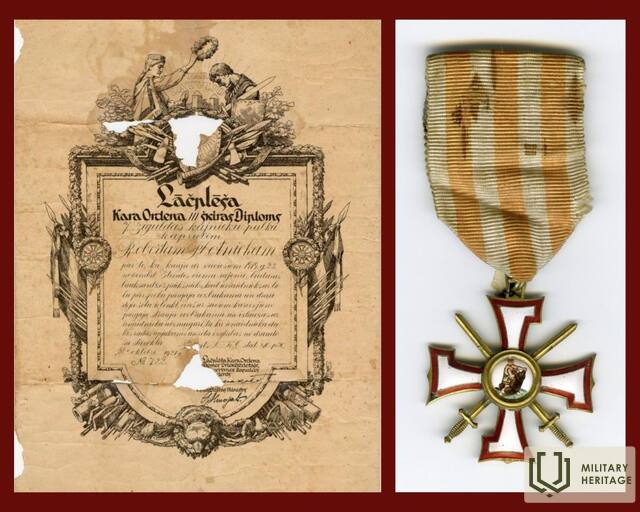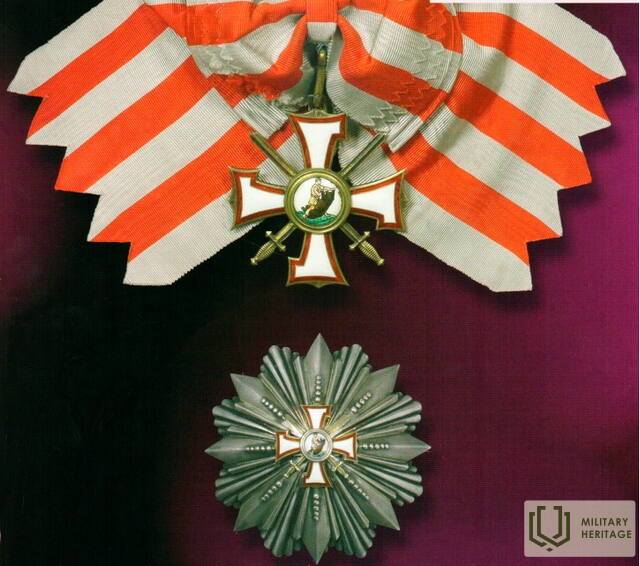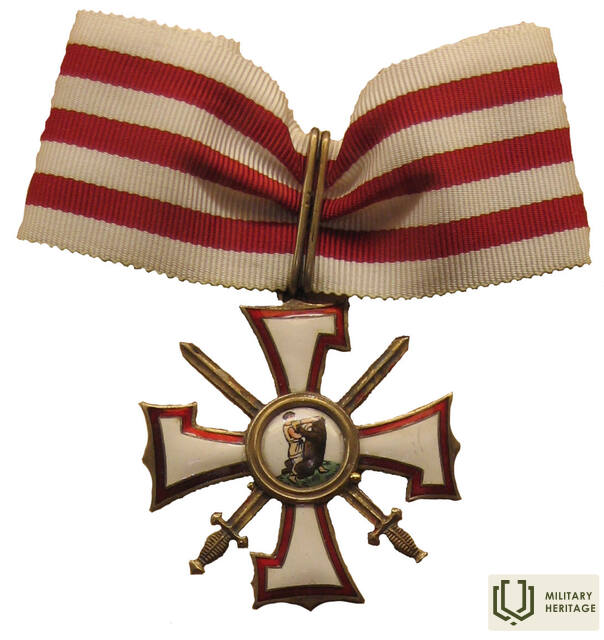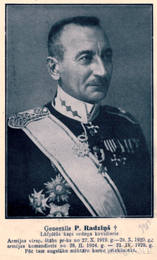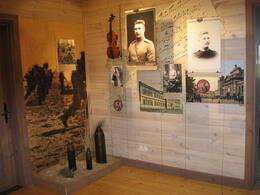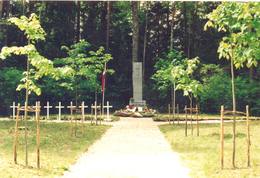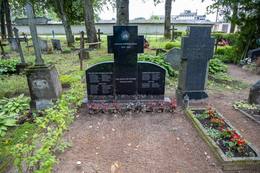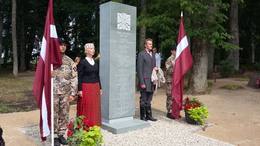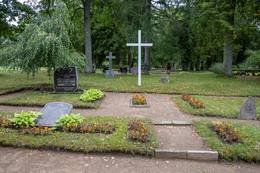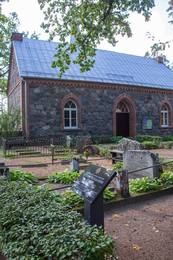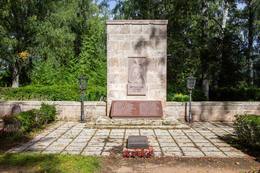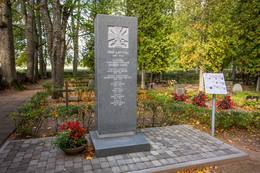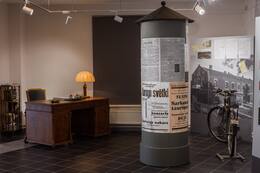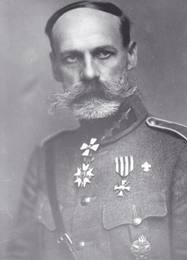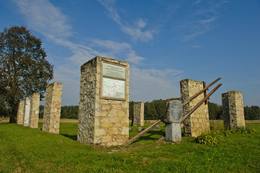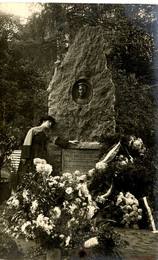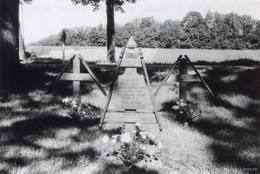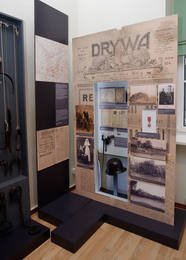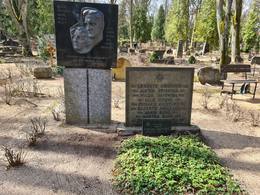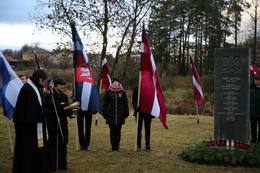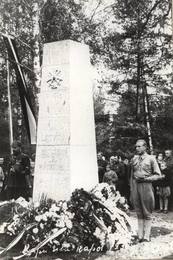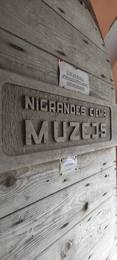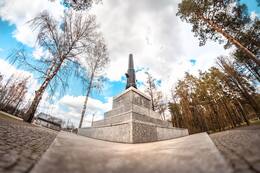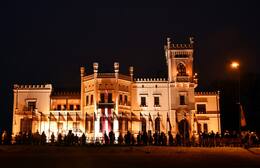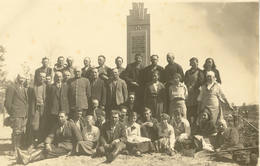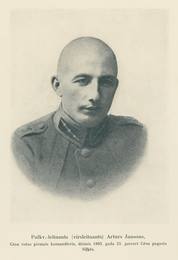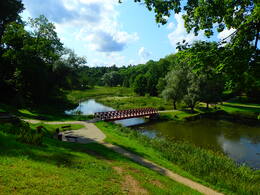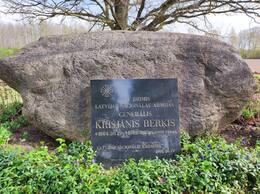Lāčplēša Kara ordenis/ kavalieri
I WW1, I Neatkarības kari
Augstāko Latvijas militāro apbalvojumu – Lāčplēša Kara ordeni – dibināja 1919. gada 11. novembrī par godu bermontiešu sakaušanai Daugavas krastos un Rīgas atbrīvošanai. Lāčplēša Kara ordenis kļuva arī par pirmo Latvijas valsts apbalvojumu. Tiesa gan, 1919. gada 11. novembris ir ordeņa simboliskais dibināšanas datums, jo ordeņa statūtus Latvijas Satversmes sapulce apstiprināja 1920. gada 18. septembrī. Pirmā apbalvošanas ceremonija notika gadu pēc Torņakalna atbrīvošanas – 1920. gada 11. novembrī Esplanādē. To piešķīra Latvijas armijas karavīriem, bijušajiem latviešu strēlniekiem un ārzemniekiem, godinot viņu devumu Latvijas neatkarības izcīnīšanā. Pirmos Lāčplēša Kara ordeņus saņēma: ģenerālis Pēteris Radziņš, pulkveži un pulkvežleitnanti Mārtiņš Peniķis, Krišjānis Berķis, Jūlijs Jansons, Jānis Apinis, Oskars Dankers un Jānis Puriņš.
Lāčplēša Kara ordeņa zīme ir balti emaljēts ugunskrusts ar sarkanu un zelta apmalojumu. Aversā centra medaljonā ir Lāčplēsis, kas cīnās ar lāci. Krusta stūros – sakrustoti zobeni. Reversā medaljonā izvietots datums – „11.novembris 1919”. Krusta zaros iegravēts „Par Latviju”, kas ir ordeņa devīze. Krusta galos iegravēti iniciāļi H.B. - sudrabkaļa Hermaņa Banka meistarzīme. Ordenim ir daudzstaru sudraba zvaigzne, kuras centrā ir ordeņa zīme. Muarē lente ar trim sarkanām un četrām sudrabotām vienāda platuma svītrām. Lāčplēša kara ordenim ir trīs šķiras – I, II un III šķira.
Apbalvošana ar Lāčplēša Kara ordeni ilga līdz 1928.gada 11.novembrim. Šo astoņu gadu laikā I šķiras Lāčplēša Kara ordenis piešķirts 11 personām (4 latviešiem un 11 ārvalstniekiem), II šķiras ordenis - 61 personai (18 latviešiem un 43 ārvalstniekiem), bet III šķiras – 2072 personām (1600 nacionālās armijas karavīriem, 202 bijušajiem latviešu strēlniekiem un 271 ārvalstniekam). LKO kavalieri baudīja virkni privilēģiju – tiesības nēsāt militāro uniformu arī pēc atvaļināšanas, atlaides dzelzceļa biļešu iegādē, tiesības saņemt bērniem atbrīvojumu no mācību maksas valsts skolās, bezmaksas medicīnisko aprūpi utml.
Ar Lāčplēša Kara ordeni kopumā apbalvoja trīs sievietes. Viena no viņām ir slavenā latviešu strēlniece Līna Čanka, kuras dzīvesstāsts jau kļuvis leģendārs. Dzimusi 1895. gadā Rendas pagasta «Mežzīlēs», 1915. gadā, tuvojoties vācu armijai, L. Čanka ar ģimeni pamet dzimtās mājas un dodas bēgļu gaitās. Nonākusi Rīgā, viņa pieņēma laikmetam neraksturīgu lēmumu — cīnīties pret iebrūkošo armiju ar ieroci rokās latviešu strēlnieku bataljonu sastāvā. Izmantojot mirušā brāļa Jāņa dokumentus un kāda pazīstama puiša labvēlību, kurš veiksmīgi izgāja medicīnas komisiju, L. Čankai izdodas nokļūt 3. Kurzemes latviešu strēlnieku bataljonā. Taču jau pavisam drīz L. Čankas dienesta biedri ziņoja priekšniecībai par strēlnieku ar neparasto uzvedību. Kad viss nāca gaismā, L. Čanku gribēja izslēgt no bataljona sastāva, taču viņa protestēja, pauda vēlmi cīnīties pret ienaidnieku un pat draudēja nošauties. Tā visa rezultātā L. Čankai atļāva palikt bataljonā.
Papildus izziņas avoti
Sargs.lv. 2015. Latviešu strēlnieki — Lāčplēša Kara ordeņa kavalieri. Pieejams: https://www.sargs.lv/lv/vienibas-un-personibas/2015-11-23/latviesu-strelnieki-lacplesa-kara-ordena-kavalieri#lastcomment [skatīts 06.05.2021].
Dvēseļu Putenis. Lāčplēša Kara ordenis, 1919-1928. Pieejams: https://www.dveseluputenis.lv/lv/laika-skala/notikums/124/lacplesa-kara-ordenis-1919-1928/ [skatīts 06.05.2021].
Sargs.lv. 2011. Lāčplēša Kara ordenis. Pieejams: https://www.sargs.lv/lv/vesture/2011-04-18/lacplesa-kara-ordenis#lastcomment [skatīts 06.05.2021].
Historia.lv. 2014. Lāčplēša Kara ordenis. Pieejams: https://www.historia.lv/biblioteka/skirklis/lacplesa-kara-ordenis [skatīts 06.05.2021].
Saistītās laikalīnijas
Saistītie objekti
Ģenerāļa Pētera Radziņa piemiņas vieta
Atrodas Valkas pagastā, braucot pa autoceļu Valka – Rūjiena (P22) 4 kilometrā, pa labi, sekojot norādes zīmēm.
Pēteris Radziņš dzimis 1880.gada 2.maijā Lugažu pagasta “Jaunvīndedzēs”. Mācījies Lugažu draudzes skolā, Valkas pilsētas skolā un Valkas Nelsona reālskolā. Iestājies kā brīvprātīgais krievu armijā. 1919.gada rudenī atgriezās Latvijā un 27.oktobrī iecelts par Armijas virspavēlnieka štāba priekšnieku, uzņemoties šo amatu brīdī, kad bermontieši apdraudēja Rīgu. Kā štāba priekšnieks vadījis visas Rīgas, Zemgales un Latgales kaujas. 1920.gada 5.februārī paaugstināts par ģenerāli.
Mūsdienās netālu no dzimtas mājas aplūkojams piemiņas akmens, kas veltīts ģenerālim Pēterim Radziņam (1880 - 1930).
2017.gada 11.novembrī Rīgā, Daugavas gates stūrī, tika atklāta piemiņas plāksne Pēterim Radziņam.
Video: Ģenerāļa P. Radziņa piemiņas pasākums Rīgas Brāļu kapos 2019.gadā
Video: 2019.gada 2. maijā, ģenerāļa Pētera Radziņa 139. dzimšanas dienā, 11.novembra krastmalā, pie Prezidenta pils, goda sardzei un interesentiem piemiņas plāksni aptverot, notika atceres pasākums.
Valkas novadpētniecības muzeja ekspozīcijā “Valka - Latvijas neatkarības šūpulis” atspoguļota arī ģenerāļa Pētera Radziņa dzīve un darbība.
Blakus tradicionālajiem krājuma eksponēšanas veidiem ekspozīcijā izmantoti interaktīvi multimediju risinājumi. Informācija un anotācijas tulkotas igauņu un angļu valodā.
Oskara Kalpaka muzejs un piemiņas vieta "Airītes"
O.Kalpaka muzejs un piemiņas vieta „Airītes” atrodas Saldus novada Zirņu pagasta „Airītēs", vecās Rīgas - Liepājas šoseja malā.
Pulkveža O.Kalpaka muzeja un piemiņas vietas „Airītes” ekspozīcija sniedz plašu informāciju par Oskaru Kalpaku, viņa vadīto bataljonu un parāda Latvijas nacionālās armijas un piemiņas vietas „Airītes” izveidošanas vēsturi. Muzeja ekspozīcija atklāj pulkvedi Oskaru Kalpaku kā personību, kā karavīru un kā cīnītāju par Latvijas neatkarību.
Sākot ar 1920.gadu par brīvprātīgi saziedotajiem līdzekļiem sabiedriskās organizācijas „Airītēs” sāka veidot piemiņas vietu pulkvedim Oskaram Kalpakam. 1922.gada 3.septembrī tur atklāja viņam veltītu pieminekli. Pēc savienības „Pulkveža Kalpaka bataljons” ierosinājuma 1935.gada vasarā iepretim piemiņas vietai sāka celt ēku pulkveža Oskara Kalpaka muzejam. Muzeju atklāja 1936.gada 6.septembrī. Ēkā izveidoja ekspozīciju par Kalpaka bataljona cīņu gaitām.
Muzejs turpināja darboties līdz 1944.gadam, kad kara apstākļos ēkā izvietojās dažādas karaspēka vienības, 1950.gadā piemiņas ansambli iznīcināja. Muzeja ēkā iekārtoja pasta nodaļu un dzīvokļus. Sākoties Atmodai, 1988.- 1989.gadā piemiņas vietu atjaunoja. 1990.gada 11.novembrī pulkveža Oskara Kalpaka muzejs atsāka savu darbību. No 1991.gada 7.novembra līdz 2006.gada 29.decembrim memoriālā piemiņas vieta bija J.Rozentāla Saldus vēstures un mākslas muzeja filiāle, bet kopš 2007.gada 2.janvāra muzejs ir Latvijas Kara muzeja nodaļa. 2007.gada 24.novembrī muzeja ēkas otrajā stāvā remontdarbu laikā izcēlās ugunsgrēks un ēkas otrais stāvs pilnībā nodega. Pēc muzeja ēkas atjaunošanas 2013.gada 6.martā atklāja no jauna izveidoto ekspozīciju, kura atspoguļo pulkveža Oskara Kalpaka personību un apskata viņa darbību I pasaules kara laikā un Latvijas Atbrīvošanas cīņās.
Ekspozīcijā ir apskatāmas unikālas vērības: priedes stumbra fragments (pie šīs priedes 1919.gada 6.martā O.Kalpaks saņēma nāvīgo ievainojumu), 1. atsevišķā latviešu bataljona atšķirības zīmes un formas tērpu atdarinājumi, J. Blūma dāvinātais Latviešu atsevišķās jātnieku nodaļas karoga atdarinājums, Latvijas neatkarības rotas kapteiņa P.Penčuka Lāčplēša Kara ordenis, kas piešķirts par kauju pie Lielauces 1919.gada 16.janvārī.
Ekspozīciju papildina izveidotie atmiņu ieraksti audio formātā (latviešu, angļu, vācu valodās). Tie lieliski papildina eksponatūras klāstu un akcentē 1918./1919. gada vēsturisko notikumu svarīgumu Latvijas valstiskuma nosargāšanā.
Muzeja ēka ir mūsdienīgi restaurēta, kā arī ekspozīcija ir mūsdienu prasībām atbilstoša. Ieeja ir bez makas, ekskursija ar gidu 10 eur stundā. Ceļa pretējā pusē atrodas piemiņas vieta. Pieejama atpūtas vieta, parks, šķēršļu trase, dažādas nodarbības, ir semināra zāle līdz 30 vietām.
Alūksnes Garnizona kapi
Atrodas Alūksnes ezera krastā, Kapsētas pussalā, Lielo kapu teritorijā.
Tie sākti veidot un uzturēti ar 7. Siguldas kājnieku pulka karavīru gādību 20. gadsimta 30-tajos gados un iesvētīti 1932. gada 11. novembrī. Pēc Latvijas neatkarības atjaunošanas rūpes par Garnizona kapu uzturēšanu, ar Alūksni saistīto LKOK atdusas vietu apzināšanu un piemiņas zīmju uzstādīšanu Garnizona kapos uzņēmās Alūksnes Brāļu kapu komitejas nodaļas vadītājs Uldis Veldre.
Garnizona kapos apglabātas Latvijas Republikas armijas militārpersonas, kā arī 1941. gada 4. jūlijā Alūksnē pie Jāņkalniņa un 1941. gada 7. jūlijā Ziemera pagastā pie Prinduļu mājām cīņā pret lieliniekiem kritušie karavīri un civilpersonas.
Vairumam apbedīto uzstādīti balti koka krusti ar metāla plāksnītēm, kurās minēts kritušā vārds, dienesta pakāpe vai nodarbošanās, kā arī dzimšanas un nāves datums.
1990. gada 19. decembrī Garnizona kapos tika atklāta piemiņas zīme Lāčplēša Kara ordeņa kavalierim Vilim Spandegam. Tipveida piemiņas plāksnes tika uzstādītas arī LKOK, kas miruši vai noslepkavoti komunistu koncentrācijas nometnēs un nav apbedīti Latvijā. 1990. gada 11. novembrī uzstādīta piemiņas zīme komunistu koncentrācijas nometnē mirušajam LKOK Voldemāram Zaķim.
Karvas Brāļu kapi
Atrodas Alūksnes - Apes ceļa malā pie Zušu mājām, uz Dienvidiem no Karvas, pagriezienā uz Rezaku.
Piemineklis atklāts 1937. gada 12. septembrī. Granīta stēla pēc Kara būvniecības pārvaldes arhitekta Vemera Vitanda meta izgatavota O. Dambekalna akmeņkaltuvē Rīgā.
1975. gadā rudenī vietējie komunisti pieminekli nopostīja. 1989. gada 30. martā Alūksnes rajona padome pieņēma lēmumu par pieminekļa atjaunošanu un 1989. gada 30. aprīlī tā vietā tika uzstādīta pagaidu koka piemiņas zīme latviskas kapa zīmes formā, ko bija darinājis Valsts elektrotehniskās fabrikas (VEF) strādnieks Jānis Jaunzems. Uz tās bija lasāms uzraksts: “Šeit tiks atjaunots Karvas Brāļu kapu piemineklis.”
Tolaik tika labiekārtoti arī līdzās esošie Brāļu kapi.
1993. gadā, pateicoties Alūksnes Brāļu kapu komitejas nodaļas vadītāja Ulda Veldres iniciatīvai, atsākās piemiņas vietas atjaunošanas darbi. Jauno pieminekli izgatavoja Cēsu akmeņkaļi brāļi Aivars, Austris un Auseklis Kerliņi.
Pieminekli atklāja 1994. gada 11. jūnijā.
Brāļu kapos apbedīti četri Valmieras kājnieku pulka 5. rotas kareivji- Jēkabs Sukse, Pēteris Leitlands, Ernests Puķītis un Gustavs Ozols, kas krituši 1919. gada 2. aprīlī kaujās pie Zušu mājām. Kā piektais 1930. gadu vidū apbedīts Valmieras pulka kareivis Roberts Glāzners, kas pazuda bez vēsts 1919. gada 31. martā pie Jaunās muižas. Sākotnēji viņš apbedīts kā nezināms, bet vēlāk vārds noskaidrots un iekalts piemineklī. Savukārt piektais Zušu kaujā kritušais kareivis Augusts Dzedons (Ziedons) apbedīts Apekalna kapos.
Pieminekļa pakājē uzstādīta piemiņas plāksne Zušu kaujas dalībniekam LKOK Jānim Goldem (1891–1952), kurš miris komunistu koncentrācijas nometnē Intā, Komi.
Otra piemiņas plāksne, kas atklāta 1992. gada 23. augustā, uzstādīta pie viena no koka krustiem un veltīta 7. Siguldas kājnieku pulka kaprālim Pēterim Jansonam, kuru 1941. gada 7. jūlijā noslepkavoja atejošie komunisti.
Piemineklis Neatkarības kara dalībniekiem un kritušajiem
Atrodas Centra kapos, Barkavas pagastā, Madonas novadā.
Netālu no Barkavas Svētā Staņislava Romas katoļu baznīcas.
Apskatāms piemineklis Latvijas Neatkarības kara dalībniekiem un kritušajiem. Piemineklis atklāts 2018. gada 11. novembrī. Tapis pēc Barkavas pamatskolas vēstures skolotājas Janīnas Liepiņas iniciatīvas.
Tas darināts melnā, slīpētā granītā un sastāv no krusta, kam no abām pusēm pieslejas divas piemiņas plāksnes, kurās kopumā iekalti to 47 novadnieku vārdi, kas piedalījušies Latvijas Neatkarības karā, tajā krituši vai saņēmuši Lāčplēša Kara ordeni, kā arī to barkaviešu vārdi, kurus lielinieki noslepkavojuši.
Līdzās aplūkojami: Piemineklis Brīvības cīņās kritušajam karavīram Jezupam Reidzānam un piemineklis 1.Liepājas kājnieku pulka kareivim Aleksandram Lakstīgalam.
Piemineklis Aleksandram Lakstīgalam atklāts 1936.g. 30. augustā. To atklāja 17. Rēzeknes aizsargu pulka komandieris Zarāns.
Pieminekli 1.Liepājas kājnieku pulka kareivim cēlusi 17. Rēzeknes aizsargu pulka 10. rota par saziedotiem līdzekļiem.
Piemiņas stēla Lāčplēša Kara ordeņa kavalieriem
Atrodas Matīšu kapos, Matīšu pagastā.
Piemiņas stēlā iekalts teksts ar to 15 Lāčplēša Kara ordeņa kavalieru vārdiem, kas saistīti ar Matīšiem, kā arī ar kaimiņos esošajiem Vilzēnu un Braslavas pagastiem, kurus savulaik apvienoja Matīšu baznīcas draudze. Tika apzināti arī tie, kas miruši ārzemēs vai apglabāti citās Latvijas vietās, bet šeit Matīšos ir dzimtas kapi.
Piemiņas stēla atklāts 2018. gada 4. augustā par godu Latvijas simtgadei.
Lāčplēša Kara ordenis (LKO) bija Latvijas augstākais militārais apbalvojums laikā no 1920. līdz 1940. gadam. LKO piešķīra par kaujas nopelniem Latvijas armijas un bijušo latviešu strēlnieku pulku karavīriem, kā arī ārzemniekiem, kuri bija devuši lielu ieguldījumu Latvijas brīvības cīņās vai citādi sekmējuši Latvijas valsts nodibināšanu. LKO devīze ir „Par Latviju”, un tam ir 3 šķiras. Pirmā šķira, ko pasniedz tikai augstiem valstsvīriem un ģenerāļiem.
Latviešu leģionāru un Neatkarības karā kritušo apbedījumi
Atrodas Cesvaines Ķinderu kapos.
Apskatāms 1997. gada jūnijā brāļu kapos atklāts granīta piemiņas akmens latviešu leģionāriem un atrodami un apskatāmi Neatakrības karā kritušo individuālie apbedījumi.
Pie kapsētas uzstādīts informācijas stends-shēma ar kritušo piemiņas un apbedījumu vietām:
1. Latviešu leģionāru brāļu kapi 1943.-1945.g.
2. Jēkabs Markovs 08.02.1883-08.08.1917. 8.Valmieras latviešu pulka strelnieks
3. “Zaļo” partizānu komandiera Arvīds Alberts Strads 22.09.1894.-05.04.1919. Virsleitnants
4. Harijas Lēcons 18.03.1914.-19.01.2003. Kapteinis
5. Jānis Purēns 15.11.1887.-18.11.1918. Lāčplēša kara ordeņa kavalieris.
Lāčplēša Kara ordeņa kavalieru apbedījumi Palsmanes kapos
Atrodas Palsmanes kapos.
Apskatāmi 7 Lāčplēša Kara ordeņa kavalieru apbedījumi.
Pateicoties projektam “Palsmanes kapsētas digitalizācija”, apmeklētājiem iespējams atrast Lāčplēša Kara ordeņa kavalieru apbedījumus:
LKOK Rūdolfa Beitika individuāls apbedījums
LKOK Kārļa Brītiņa individuāls apbedījums
LKOK Roberta Kukurīša individuāls apbedījums
Brāļu LKOK Jūlija Zīles un LKOK Riharda Zīles individuālie apbedījumi
LKOK Ernesta Lielmaņa individuāls apbedījums
LKOK Pētera Rabača individuāls apbedījums
Kartē ar zvaigzni atzīmēti individuālie apbedījumi.
2019.gadā par godu Lāčplēša kara ordeņa dibināšanas 100 gadadienai, kā arī, lai godinātu novada karavīrus, kuri apbalvoti ar Lāčplēša kara ordeni, 11. novembrī svinīgi tika atklātas izveidotās piemiņas vietas Palsmanes kapsētā.
Izvietotas piemiņas zīmes un informācijas stendi par novada LKO kavalieriem.
Piemineklis Neatkarības karā kritušo smilteniešu piemiņai
Atrodas Smiltenes luterāņu kapos Vaļņu ielā 11.
Piemineklis Neatkarības karā kritušo smilteniešu piemiņai atklāts un iesvētīts 1937. gada 7. novembrī. Piemineklis celts no betona un apšūts ar Allažu šūnakmens plāksnēm. Piemineklis veidots pēc arhitekta Vernera Vitanda meta, tēlnieks Matīss Pluka.
Pieminekļa priekša 1937. gada 31. oktobrī no ģimenes kapiem pārapbedīja 1919. gada 6. martā kaujā pie Airītēm kritušā virsleitnanta, Lāčplēša Kara ordeņa kavaliera Pētera Krieva mirstīgās atliekas. 1937. gada 7. novembrī pie viņa kapa kopiņas nolika melnā granīta piemiņas plāksni.
Kapsētā apglabāti vairāki kritušie latviešu strēlnieki un Neatkarības karā kritušie Latvijas armijas karavīri. Smiltenes ev.lut. baznīcā abpus altārim 1927. gada 2. oktobrī prāvests Kārlis Kundziņš iesvētīja 2 baltā marmora piemiņas plāksnes.
Ģenerāļu un Lāčplēša Kara ordeņa kavalieru piemiņas vietas Trikātas pagastā
Piemiņas stēla atrodas līdzās Trikātas kapu kapličai.
Trikātas kapi glabā trīs izcilu Latvijas ģenerāļu - Roberts Dambītis, Kārlis Goppers un Jānis Balodis, piemiņu. Trikātas kapos apglabāts arī visu šo ģenerāļu skolotājs Jēkabs Mūrnieks, kuram 1928. gadā uzstāda apbedījuma vietā pēc Kārļa Zāles meta šūnakmenī veidotu pieminekli.
Ģenerāļus un Lāčplēša Kara ordeņa kavalierus katru gadu piemin ar lāpu gājieniem uz Trikātas kapiem, kur atrodas divas piemiņas stēlas, kurās kopumā iekalti 17 ar Trikātas pagastu saistīto Lāčplēša Kara ordeņa kavalieru vārdi.
Stēla atklāta 2018. gada 11. novembrī.
Video sižets par Lāčplēša kara ordeni un ordeņu komplektu, kas piederēja ģenerālim Jānim Balodim.
Piemiņas stēla Lāčplēša Kara ordeņa kavalieriem
Atrodas blakus Kauguru kapsētas kapličai.
Apskatāma piemiņas stēla un informācijas stends ar katra Lāčplēša Kara ordeņa kavaliera biogrāfiju, cīņu vietām un atdusas vietu.
Stēlā iekaltais teksts ir nedaudz maldinošs, jo Kauguru kapos apbedīti tikai divi LKOK – A. Ābeltiņš un Ē. Radziņš, bet pārējie stēlā minētie ar Kauguru pagastu saistīti citādā veidā – vai nu tajā dzimuši, vai kādu laiku dzīvojuši.
Lāčplēša Kara ordenis (LKO) bija Latvijas augstākais militārais apbalvojums laikā no 1920. līdz 1940. gadam. LKO piešķīra par kaujas nopelniem Latvijas armijas un bijušo latviešu strēlnieku pulku karavīriem, kā arī ārzemniekiem, kuri bija devuši lielu ieguldījumu Latvijas brīvības cīņās vai citādi sekmējuši Latvijas valsts nodibināšanu. LKO devīze ir „Par Latviju”, un tam ir 3 šķiras. Pirmā šķira, ko pasniedz tikai augstiem valstsvīriem un ģenerāļiem.
Stēla atklāta 2018. gada 11. novembrī.
Ekspozīcija „Latvijas armija Pļaviņās 20. gs.”
Atrodas Odzienas ielā 2, Pļaviņās.
Apskatāma pastāvīgā ekspozīcija „Latvijas armija Pļaviņās 20. gs.”.
Ēkai Pļaviņās, Odzienas ielā 2, ir sena vēsture – no laika, kad Stukmaņu lieltirgotājs Hugo Apeltofts tajā uzsāka aktīvu saimniecisko darbību, tādējādi veicinādams Pļaviņu pilsētas attīstību, līdz brīdim, kad Brīvības cīņu jeb Neatkarības kara laikā šeit tika izveidots Latvijas Austrumu frontes štābs. 1919. gadā tieši no Pļaviņām tika vadīta Latvijas armijas vienību darbība pret Sarkano armiju Latgalē.
1934. gadā pie šī nama tika atklāta piemiņas plāksne ar uzrakstu: “Šai namā 1919. gadā atradās Austrumu frontes štābs, un šeit ģenerālis Jānis Balodis uzņēmās Latvijas Nacionālās armijas virspavēlniecību.” Padomju vara 1940. gadā to noņēma un iznīcināja, bet 1990. gada 16. jūnijā ar LNNK Pļaviņu nodaļas atbalstu tā tika atjaunota.
Tagad pie kādreizējā štāba ēkas atrodas piemiņas stēla, kas veltīta 15 Pļaviņu novadā dzimušajiem Lāčplēša Kara ordeņa kavalieriem, bet telpās izveidota ekspozīcija „Latvijas armija Pļaviņās 20. gs.”, kura stāsta par notikumiem Brīvības cīņu laikā, Latvijas armijas 3. Latgales divīzijas štāba darbību Pļaviņās, kā arī sniedz ieskatu Lāčplēša Kara ordeņa kavalieru dzīves stāstos.
Netālu no ekspozīcijas ēkas atrodas Latgales divīzijas štāba ēka, kuru 1913. gadā, kā Stukmaņu liķiera fabiku būvēja grāfs Teodors Medems. 1919.gadā to pārņēma P. Stučkas režīms, kur tas bija izveidojis arī cietumu. Pēc boļševiku padzīšanas, 1925.gadā ēku pārņēma Latvijas armija, kura tajā izvietoja Latgales divīzijas štābu. Šajā ēkā savu militāro karjeru izgāja 10 Latvijas armijas ģenerāļi un citi virsnieki. 1940.gadā ēku pārņēma Sarkanā armija. Pēckara gados tajā izvietojās skola, kā arī pašvaldība. Ap 1970.gadu ēku sāka izmantot ražošanas apvienība “Rīgas Apģērbs”.
Ekspozīcijas apmeklējumu iepriekš jāpiesaka zvanot T. 28442692.
Ģenerāļa Kārļa Goppera piemiņas istaba dzimtajās mājās "Maskati"
Atrodas Plāņu pagastā uz Vijas upes krasta.
Apskatāma ģenerāļa Kārļa Goppera piemiņas istaba dzimtajās mājās "Maskati".
“Maskatu” saimniecību vadīja ģenerāļa brālis Augusts Goppers, jo talantīgais kara vadonis bija aizņemts lielajos notikumos un pasaules karos. 1920. gadā ģenerālis atgriezās Latvijā, savās dzimtajās mājās. Bet daudzi atbildīgie pienākumi viņu saistīja ar Rīgu. “Maskatos” turpināja saimniekot Augusts. 1940. gadā ģenerāli Gopperu arestēja un 1941. gada 25. martā nošāva čekas pagrabos. 1944. gadā Gopperu dzimta ar trijiem zirgu pajūgiem devās bēgļu gaitās uz Kurzemi. Karš dzimtu sadalīja, Latvijā palika Aleksandra Goppera meitas – Biruta, Elza un Anna. “Maskatos” atgriezties viņas vairs nedrīkstēja. Mājas bija lielas un rūpīgi koptas. Tur pa atsevišķām istabām tika izmitinātas trīs četras ienācēju ģimenes. Lielajā kūtī iekārtoja zirgu fermu. Savstarpēju kašķu dēļ 1980. gadā izcēlās ugunsgrēks. Nodega kūts un lielais šķūnis. Laimīgā kārtā uguns nepārsviedās uz dzīvojamo māju, liesmas atvairīja senču stādītie lielie koki.
1991. gadā pēc brīnumainās Atmodas otrreiz atdzima Latvijas valsts. 1992. gadā ģenerāļa Goppera brāļa Augusta dzimta atguva “Maskatus” kā senču svētumu. Desmit gadus visi sūri, grūti strādāja, lai glābtu mājas no bojāejas, lai atjaunotu un uzceltu nopostītās ēkas, lai darītu skaistu visu “Maskatu” sētu. Mājas ir atjaunotas senajā izskatā, ir iekārtota arī ģenerāļa Kārļa Goppera piemiņas istaba.Piemiņas istabu iespējams apmeklēt iepriekš zvanot un piesakot apmeklējumu +371 29396870, +371 29254285.
Komunistiskā terora upuru piemiņas vieta Jaunraunas pagasta represētajiem
Atrodas "Baižēni", Priekuļu pagastā
Piemiņas vieta represētajiem izveidota “Baižēnu” māju šķūņa drupu vietā, kurā 1949.gadā naktī uz 25.martu tika turēti 40 Jaunraunas pagasta iedzīvotāji, lai no rīta to ceļš vestu tālāk uz Lodes dzelzceļa staciju un Sibīriju.
Represēto vidū bija bērni līdz 1 gada vecumam un 87 gadus veci sirmgalvji.
Uz piemiņas plāksnes rakstīti arī to vārdi, kuri nošauti vai miruši izsūtījumā. Līdzās atrodas piemiņas akmeņi Lāčplēša kara ordeņa kavalieriem.
Lubānas tūrisma un kultūrvēsturiskā mantojuma centra patstāvīgā ekspozīcija
Atrodas Lubānas pilsētas centrā, Oskara Kalpaka ielā 4.
Lubānas tūrisma un kultūrvēsturiskā mantojuma centrs, kas atrodas pašā Lubānas pilsētas centrā, ir vieta, kur kā vietējie, tā arī tūristi var iepazīties ar dažādām izstādēm un pastāvīgām ekspozīcijām, tajā tiek eksponēti vēsturiski svarīgi materiāli un vēsturiskas liecības, kas stāsta par Lubānas un tās novada vēsturi, kultūru, tradīcijām un dzīvi novadā.
Šeit ir iespēja apskatīt patstāvīgās ekspozīcijas par cilvēkiem, ar kuriem Lubānas iedzīvotāji īpaši lepojas un vēlas pieminēt. Pašlaik centrā ir iespēja aplūkot patstāvīgās ekspozīcijas par:
Nacionālās pretošanās kustības dalībnieci un politieslodzīto, dzejnieci Broņislavu Martuževu;
Neatkarības kara dalībnieku un politiķi Hugo Celmiņu;
Latvijas armijas pirmo virspavēlnieku Oskaru Kalpaku;
fotogrāfu Alfredu Grāveru;
operdziedātāju Jāni Zāberu;
dzejnieku Jāni Gavaru;
mākslinieku Rūdolfu Pinni;
folkloristu un mācītāju Mārtiņu Celmiņu.
Centra vadītāja Ilze Kraukle var sniegt gida pakalpojumus par Lāčplēša kara ordeņu kavalieru un brīvības cīnītāju gaitām Lubānā un tās apkārtnē un to atdusas vietām Lubānas vecajos kapos.
Valoda - latviešu, krievu, bet ja ir nepieciešams, iepriekš var pieteikt vācu un angļu valodas tulku.
Piemineklis Neatkarības karā kritušajiem karavīriem
Atrodas Valkā Varoņu ielā blakus Meža kapiem.
Apskatāms piemineklis 30 Latvijas Neatkarības karā kritušiem 1. (4.) Valmieras kājnieku pulka karavīriem.
Piemineklis atklāts 1922. gada 1. oktobrī. Tas sastāv no vietējā iesārtā granītā kalta senlatviešu karotāja figūras (“Sencis”), kas novietota uz divdaļīga, no pelēka granīta veidota pjedestāla. Piemineklim izvēlēts tēlnieka Emīla Meldera (Millera) mets. Pieminekļa kalšanā līdz ar Melderi piedalījās arī tēlnieks Vilhelms Treijs.
Tas ir pirmais profesionāla tēlnieka veidotais Latvijas Neatkarības kara piemineklis, kā arī vienīgais starpkaru periodā, kas darināts modernisma stilā, izmantojot kubisma elementus.
Atkārtotās komunistiskās okupācijas laikā 1951. gadā pieminekļa skulptūra tika nogāzta, daļēji sabojāta un aprakta. Nolīdzināti tika arī apbedījumi.
1988. gadā, kad tuvojās tēlnieka E. Meldera (1889-1979) simtgade, tika uzsākta viņa darbu apzināšana.
Atjaunotie brāļu kapi līdz ar restaurēto pieminekli tika atklāti 1990. gada 11. novembrī.
2017. gadā brāļu kapos tika uzstādītas astoņas piemiņas stēlas ar Valku saistītajiem Lāčplēša Kara ordeņa kavalieriem. Tās izvietotas abpus piemineklim – pa četrām stēlām katrā pusē.
Piemineklis jūras virsleitnantam, L.k.o.k. Vilim Ģelbem (1890-1919)
Atrodas Limbažu Jūras ielas kapos, Jūras iela 56, Limbažos
Apskatāms 1922. gada 10. septembrī toreizējais Latvijas Valsts prezidents Jānis Čakste atklāts piemineklis, uz kura lasāms dzejnieka Viļa Plūdoņa veltījums Vilim Gelbem:
«Tautiet, kas garām man eji, iededzies tēvzemes mīlā,
par tēvzemi mīļo, es dzīvību atstāju ķīlā.»
Vilis Gelbe (1890-1919) dzimis Kurzemē, Zemītes pagastā, taču cieši saistīts arī ar Limbažu pusi, jo, sākoties Latvijas Neatkarības karam, no Pēterburgas atgriezās Latvijā un iestājās Ziemeļlatvijas brigādē.
1919. gada maijā V.Gelbi komandēja uz Limbažiem, viņš kļuva par apkārtnes kara komandantu un spēja iedvesmot šejienes vīrus un arī vēl pavisam jaunus puišus pievienoties armijai.
V. Gelbes toreizējā darbība Limbažos un to apkārtnē bija ļoti nozīmīga, viņa pienākumos ietilpst ne tikai kārtības uzturēšana pilsētā un apkārtnē, bet arī mobilizācija, pārtikas sagādāšana karavīriem un zirgiem un daudzu citu jautājumu risināšana, ko nevar ietvert pavēlēs un instrukcijās. Viņa organizētā komandantūras komanda darbojās kā saskaņots mehānisms, lai Ziemeļlatvijas brigādei sniegtu pēc iespējas efektīvāku palīdzību. Komandantūras komanda sevišķos gadījumos devās palīgā regulārajai armijai, un viņš rādīja priekšzīmi jaunkareivjiem. V. Gelbe bija pirmais Latvijas armijas virsnieks, kurš savus padotos ierosināja apbalvot ar Imantas ordeņa III šķiru. Ordeņa gan vēl nebija. Imantas vārds atklātībā parādījās tikai 1920. gada 20. martā, kad apsardzības ministram Kārlim Ulmanim tika iesniegts izklāsts par kara ordeņa dibināšanu. Ordenim tomēr izvēlējās Lāčplēša vārdu.
Cēsu kauju laikā Vilis Gelbe gāja bojā - 1919. gada 19. jūnijā izlūkgājiena laikā. Vēlāk Gelbem piešķīra Lāčplēša Kara ordeni, tomēr vēsturnieki spriež - kopumā viņa devums līdz šim nav bijis pienācīgi novērtēts. Galvenokārt tas skaidrojams ar Gelbes piederību Ziemeļlatvijas brigādei.
Savā starpā konkurēja tā saucamā Dienvidlatvijas brigāde, kas bija sākotnēji Oskara Kaplaka, vēlāk Jāņa Baloža komandēta, ar Ziemeļlatvijas brigādi, kas bija Jorģa Zemitāna komandēta.
Vidrižos piemiņas zīme vietā, kur kritis LKOK Vilis Gelbe un divi viņa komandas karavīri
Vidrižos pie pagrieziena uz Lēdurgu, Brīvības cīņu laikā 1919.gada 19.jūnijā, kaujā krita jūras virsleitnants Vilis Gelbe un divi karavīri.
Vilis Gelbe apglabāts Limbažu kapos. Par varoņdarbu pie Vidrižu muižas Vilis Gelbe apbalvots ar Lāčplēša Kara ordeņa III šķiru (Nr. 895).
Šobrīd kaujas vietā apskatāmi trīs pemiņas krusti, kas uzstādīti 1989.gadā.
1934. gada 22. jūnijā pie muižas parkā augošās kļavas tika atklāta pēc mākslinieka Stefana Berca meta darināta bronzas piemiņas plāksne. Jau komunistiskās okupācijas sākumā 1940. gada rudenī piemiņas plāksne pazuda. Arī kļava, pie kuras tā bija pienaglota, gājusi bojā. Sākoties Atmodai, 1989. gada 19. jūnijā, Gelbes un divu viņa komandas karavīru – kaprāļa Krustiņa un kareivja Krūzes – nāves 70. gadskārtā, ceļu krustojumā, kur kādreiz atradās piemiņas plāksne, pēc Vides aizsardzības kluba un Latvijas Tautas frontes Limbažu novada nodaļu iniciatīvas, uzstādīja trīs Jāņa Eglīša tautiskā stilā darinātus koka krustus. Ar Limbažu rajona izpildkomitejas lēmumu 1991. gada aprīlī šī piemiņas vieta iekļauta vietējās nozīmes vēstures pieminekļu sarakstā.
Preiļu Vēstures un lietišķās mākslas muzeja ekspozīcija "Muzeja stāsti Latvijai"
Atrodas Preiļu kultūras centra telpās.
Apskatāma Preiļu Vēstures un lietišķās mākslas muzeja (PVLMM) ekspozīcija "Muzeja stāsti Latvijai" par Pirmo pasaules, Neatkarības karu un Otro pasaules karu.
Preiļu vēstures un lietišķās mākslas muzeja ekspozīcijas "Muzeja stāsti Latvijai" (atklāta 2018. gadā) sadaļa ""Drywys" stāsts" veltīta Pirmajam pasaules karam, Neatkarības karam un Latgales atbrīvošanai, kā arī Lāčplēšana kara ordeņa kavalieriem. Ekspozīcijas sadaļa "Karoga stāsts" vēsta par Otrajam pasaules kara perioda sarežģītajiem notikumiem, kura laikā preiliešus skāra deportācijas, holokausts, iesaiste karojošo pušu militārajās vienībās, pēc kara - nacionālo partizānu rindās. Apskatāma arī preilietim, ebreju glābējam Vladislavam Vuškānam piešķirtā medaļa “Taisnīgais starp tautām”.
Iepriekš piesakoties, pieejama ekskursija krievu un angļu valodā.
Piemineklis pirmajam Skolnieku rotas kritušajam karavīram Edgaram Krieviņam
Atrodas Valmieras pilsētas Centra kapos, netālu no kapličas (Miera iela 1/3, Valmiera)
Cēsu pulka 8. (Skolnieku) rotas karavīrs, LKOK Edgars Krieviņš (1899-1919), miris 7. jūnijā no ievainojumiem, kas tika gūti Cēsu kaujās 1919. 6. VI., kad, landasvēram uzbrūkot, viņš sedza pārējo daļu atiešanu.
Piemiņas stēla Lāčplēša kara ordeņa kavalieriem
Atrodas līdzās Viļakas Jēzus Sirds Romas Katoļu baznīcai.
Piemiņas stēla Lāčplēša kara ordeņa kavalieriem Viļakas novadā atklāta 2017.gada 11.novembrī. 28 Lāčplēša Kara ordeņa kavalieru likteņi ir saistīti ar Viļakas novada vārdu.
Granīta stēla tapusi Latvijas valsts simtgadei veltītā projekta “Atceries Lāčplēšus” ietvaros. Godinot Latvijas Brīvības cīņās kritušos karavīrus, visā Latvijā tiks uzstādītas vienota parauga piemiņas stēlas. Projekta iniciators ir Jaunsardzes un informācijas centrs.
Pieci Lāčplēša kara ordeņa kavalieri, kuru vārdi iegravēti piemiņas stēlā, pēc Brīvības cīņu noslēguma dzīvoja tagadējā Viļakas novada teritorijā:
– Jānis Kuļšs bija jaunsaimnieks Šķilbēnu pagasta Apsīšos,
– Aleksejs Ļubimovs (Lavrentjevs) dzīvoja Šķilbēnu pagasta Fortepjanovas fermā, vēlāk Viļakā,
– Teodors Mende saimniekoja viņam piešķirtajā saimniecībā un bija mežsargs Žīguru pagasta Katlešu ciemā,
– Eduards Tenisons dzīvoja Vecumu stacijā, vēlāk dzīvoja Čabatrovas ciemā un strādāja p/s “Viļaka”,
– Jānis Burmeistars pēc 1928. g. kādu laiku dzīvojis Šķilbēnu pagastā.
Brāļu kapi Viļakas novadā ir atdusas vieta 45 karavīriem, kuri 1920. gadā atdeva savas dzīvības, aizstāvot Latviju no lieliniekiem. 9. janvāris bija diena, kad uzbrukumi sākās Ziemeļlatgalē, un, neskatoties uz toreiz esošajiem sarežģītajiem laikapstākļiem, tajā pašā dienā arī tika atbrīvota Viļaka.
Latgales atbrīvošanas kaujās Viļakas novadā plecu pie pleca kopā ar Latvijas armijas karavīriem un partizāniem pret Sarkano armiju cīnījās arī Igaunijas karavīri. Daudzi no viņiem atdeva savu dzīvību par brīvu Latviju.
Nīgrandes muižas klēts
Nīgrandes novadpētniecības materiālu krātuve atrodas Nīgrandes ciematā muižas klētī, blakus Nīgrandes pamatskolai un ir pieejama ar iepriekšēju pieteikšanos.
Krātuvē militārās vēstures sadaļā apskatāma ekspozīcija par 2.Pasaules karu un oriģinālie priekšmeti un to daļas, kas atrasti apkārtnē pēc kara un vēlākajos gados. Tāpat ir iespēja uzzināt stāstus un apskatīt fotogrāfijas par Nīgrandi un tās apkārtni sākot no Neatkarības kara, par 2.Pasaules karu un pēckara laiku, kā arī dzīvi kolhozā padomju laikos.
Ekspozīcijā īpaša vieta ierādīta novadniekam un rakstniekam Jēkabam Janševskim un viņa darbiem, ir iekārtota ekspozīcija, kas iepazīstina ar tradicionālo muižu sadzīvi un iekārtojumu. Nīgrandes muižas klētī apskatāma arī Nīgrandes pusē atrasta mamuta ilkņa mulāža.
Līvānu atbrīvošanas piemineklis
Piemineklis atrodas Fabrikas un Stacijas ielu krustojumā, kur to 1935. gada 9. jūnijā atklāja ģenerālis Rūdolfs Bangerskis, godinot 1919. gadā Līvānu atbrīvošanas kaujās kritušo karavīru piemiņu.
Tā galvenais elements – 15 tonnas smags, vertikāli novietots lielgabala stobrs. 1958. gadā padomju vara Līvānu brīvības simbolu demontēja, lielgabala stobru sagriežot metāllūžņos. Lielgabala lodes iedzīvotāji saglabāja visus padomju gadus, un iepriekšējā vietā tās atgriezās pēc vesela pusgadsimta. Pieminekļa atjaunošanas ideja tautā visus šos gadus bija dzīva. Līvānu novada dome kopīgi ar iedzīvotājiem aktīvi darbojās pieminekļa atjaunošanā. Tika vākti tautas ziedojumi, un 2004. gada 3. oktobrī atjaunoto Līvānu Atbrīvošanas pieminekli atklāja tā vēsturiskajā vietā pilsētas parkā.
Uzraksts uz pieminekļa: “Krituši par Latviju pie Līvāniem un apkārtnes atbrīvošanas 1919. gadā Jelgavas kājnieku pulka karavīri. Bijušā Ziemeļlatvijas partizānu pulka karavīri.”
Seko karavīru un partizānu vārdi.
Līdzās uzstādītas piemiņas plāksnes Lāčplēša kara ordeņa kavalieriem Līvānu novadā.
Pieminekļa meta autors arhitekta Pāvils Dreimanis.
1919. gada 3.–5. oktobris. Līvānu kauja
1919. gada 3. oktobrī lielinieki saņēma spēcīgu triecienu frontē pie Līvāniem. Uzbrukumā Līvāniem iesaistījās 3. Jelgavas un 4. Valmieras kājnieku pulka vienības, kā arī Latvijas vācu zemessardzes (bijušā landesvēra) vienības. Ar artilērijas atbalstu 3. Jelgavas kājnieku pulka vienības pārcēlās pāri Daugavai. Pēc sekmīgās pārcelšanās sākās kaujas par Līvāniem, kas ilga visas dienas garumā. Ap plkst. 17:30 tika ieņemta Līvānu stacija, bet stundu vēlāk tika pārieti tilti pār Dubnas upi. Kopīgiem spēkiem izdevās lieliniekus padzīt no Līvāniem, plkst. 19:00 pilsētai bija pilnībā atbrīvota. 1919. gada 5. oktobrī lielinieki centās atgūt Līvānus, uzbrūkot 3. Jelgavas un 4. Valmieras kājnieku pulku jaunajām pozīcijām. Latvieši ar grūtībām noturēja ieņemtās pozīcijas. Šis bija pirmais nopietnais un sekmīgais uzbrukums Austrumu frontē laika posmā no 1919. gada jūlija līdz oktobrim.
Alūksnes muzejs
Atrodas Alūksnes Jaunās pils telpās.
Alūksnes muzeja piedāvājumā militārais mantojums atspoguļojas pamatekspozīcijās: "Totalitārajā režīmā cietušo piemiņas istaba", kas veidota represiju atcerei un atklāj Alūksnes novada iedzīvotāju likteņgaitas Sibīrijā un Tālajos Austrumos, un Alūksnes vēstures ekspozīcijā "Laikmetu mielasts", kur satiekas laika periodi no aizvēstures līdz mūsdienām. Atsevišķa nodaļa ekspozīcijā veltīta 7. Siguldas kājnieku pulka ieguldījumam militārajā jomā, kultūras un sabiedriskajā dzīvē.
7. Siguldas kājnieku pulks no 1919. gada 20. aprīļa sācis formēties kā 3. Jelgavas kājnieku pulks, no 25. augusta nosaukums – 7. Siguldas kājnieku pulks. Siguldas kājnieku pulks piedalījās kaujās pret Bermontu, tad 1920. gada 5. janvārī ieradās Latgales frontē, kur piedalījās daudzās kaujās, tajā skaitā pie Katlešiem, Vecumu un Purvmalas stacijām, kā arī Jaunlatgales un Augšpils atbrīvošanā. Pēc miera līguma noslēgšanas pulks apsargāja robežu no Rītupes stacijas līdz Igaunijas robežai. Brīvības cīņās krituši 68 karavīri, ar Lāčplēša Kara ordeni apbalvoti 85 karavīri.
Alūksnes muzejs atrodas Valsts nozīmes arhitektūras piemineklī - Alūksnes Jaunajā pilī, kas celta neogotikas stilā 19.gs. beigās. Latvijas pirmās brīvvalsts laikā Alūksnes Jaunajā pilī bija izvietots 7.Siguldas kājnieku pulks.
Pēc Otrā pasaules kara pili pārņēma padomju drošības iestādes, bet no 1950-to gadu beigām pilī darbojušās dažādas kultūras iestādes – izpildkomitejas Kultūras un Kinofikācijas nodaļa, pionieru nams, bibliotēka, bērnu bibliotēka, kinoteātris un muzejs.
Piemineklis Pirmā pasaules karā un Latvijas atbrīvošanas karā kritušajiem Annas pagasta karavīriem
Atrodas Annas pagasta Ezeriņu kapsētas centrālajā daļā.
Kapsētā, kurā apbedījumi veikti no 1925. gada atrodas par Annas pagasta Aizsargu nodaļas savāktajiem līdzekļiem uzceltais un 1933. gadā atklātais piemineklis Pirmā pasaules karā un Latvijas atbrīvošanas karā kritušajiem Annas pagasta karavīriem. Līdz Otrajam pasaules karam par pieminekļa kopšanu rūpējas Annas pagasta aizsardzes, kuras katru svētdienu devās uz kapsētu un, godinot kritušos, nolika ziedus. 1940. gada 18. novembrī piemineklis sašauts, ložu atstātās pēdas redzamas aizvien. Mūsdienās kapsētā ik gadu notiek Lāčplēša dienai veltītie piemiņas pasākumi.
2004. gadā kapos atklāta piemiņas vieta 1941.un 1949. gada politiski represētajiem, bet 2006. gadā atklāta piemiņas plāksne nacionālajiem partizāniem.
Piemineklis Cēsu rotas pirmās kaujas vietā
Atrodas Drabešu pagastā Vidzemes šosejas 79. kilometrā.
Redzams no granīta veidots piemineklis, kurā iekalta stilizēta lielinieku iebrukuma ceļa shēma.
Piemineklis atklāts un iesvētīts. 2018. gada 28. decembrī.Drabešu pagastā 1918. gada 24.decembrī kapteiņa Artūra Jansona (1893 - 1941) izlūku komanda ar smagā ložmetēja uguni aizkavēja Sarkanās armijas izlūku virzīšanos no Cēsīm uz Ieriķiem. Tā bija pirmā latviešu karaspēka bruņotā sadursme ar Padomju Krievijas Sarkano armiju.
Misiņkalna militārā mantojuma taka
Misiņkalna dabas parks atrodas Aizputes pilsētā.
Misiņkalns ir Aizputes pilsētas augstākā vieta. Tā augstums sasniedz 95,4 m. No virsotnes paveras ainavisks skats uz pilsētu. Misiņkalna dabas parku uzsāka veidot 20. gs. sākumā. Parka platība šobrīd ir aptuveni 28 ha.
Parka teritorijā atrodas vairākas ar 20.gadsimta vēstures notikumiem saistītas vietas un piemiņas zīmes - Latvijas Brīvības cīņās kritušo karavīru - Lāčplēša ordeņa kavalieru piemiņas stēlas, Holokausta memoriāla vieta, represēto piemiņas vieta un kritušo sarkano partizānu piemiņas akmens.
Parkā iespējams iepazīt dažādu retu sugu augus un stādījumus, kā arī izbaudīt neskarto dabu. Šobrīd parku caurvij atjaunoti pastaigu un velo celiņi, parka teritorijā atrodas mototrase, kurā norisinās Latvijas mēroga sacensības motokrosā.
Lai pilnīgāk iepazītu Misiņkalna muižas parka kultūrvēsturisko mantojumu, iesakām izmantot gida pakalpojumus.
Stēlas Lāčplēša kara ordeņu kavalieru piemiņai
Ar Aizputes novadu ir saistīti divdesmit septiņi Lāčplēša Kara ordeņa kavalieri.
Godinot Latvijas Brīvības cīņās kritušos karavīrus, visā Latvijā tika uzstādītas vienota parauga piemiņas stēlas, kurās teksta gravējuma šrifts atbilst varoņu piemiņas plākšņu standartam, kas ir analogs Rīgas Brāļu kapu un Centrālo kapu lauka smilšakmens piemiņas zīmju gravējumam.
Granīta stēlas tapušas Latvijas valsts simtgadei veltītā Jaunsardzes un informācijas centra projekta “Atceries Lāčplēšus” ietvaros.
Stēla "Neatkarības kara varoņiem" Jaunjelgavā
Jaunjelgavas novadā dzimušajiem Lāčplēša Kara ordeņa kavalieriem veltīta piemiņas zīme. Stēla atklāta 2017. gada 2. novembrī. Ap divus metrus augstajā piemiņas zīmē iekalti no konkrētā novada nākušo Lāčplēša Ordeņa kavalieru vārdi un dzīves gadi. Otrā stēlas pusē iekalts teksts: “Latvijas Brīvības cīņu varoņiem Latvijas simtgadē”
"Šādu 1918. – 1920. gada Latvijas Neatkarības kara varoņiem veltītu tipveida piemiņas zīmju uzstādīšana visos Latvijas novados notiek saskaņā ar projektu “Atceries Lāčplēšus”, ko aizvadītajā gadā rosināja Aizsardzības ministrijas un Jaunsardzes informācijas centrs. Ap divus metrus augstās piemiņas stela veidota pēc mākslinieka Jāņa Strupuļa meta no pelēkā Somijas granīta.
Ģenerāļa K. Berķa piemiņas vieta
Piemineklis ģenerālim Krišjānim Berķim (1884. - 1942.) uzstādīts dzimtās mājas vietā pie ozola. Pieminekli par saviem līdzekļiem uzstādījusi Latvijas Nacionalo karavīru biedrība 1998.gada 26.aprilī. Kr. Berķis bija Latvijas armijas ģenerālis, Latviešu strēlnieku komandieris, karojis Pirmajā pasaules karā un Latvijas brīvības cīņās. Lāčplēša Kara un Triju zvaigžņu ordeņu kavalieris. Latvijas bruņoto spēku komandieris, Latvijas Kara ministrs.
Krišjānis Berķis dzimis 1884. gada 26. aprīlis Īslīces pagasta Bērzukrogā. 1903. gadā, pēc Bauskas pilsētas skolas beigšanas, Kr. Berķis iestājās Viļņas junkurskolā, kuru pabeidza pēc 3 gadiem kā podporučiks. Dienēja Somijas 2. strēlnieku pulkā Helsinkos. 1909. gadā Kr. Berķis saņēma poručika dienesta pakāpi, 1913. gadā – štābkapteiņa un 1917. gada janvārī – kapteiņa dienesta pakāpi. 1917. gada jūlijā Kr. Berķis saņēma apakšpulkveža dienesta pakāpi un kļuva par 6. Tukuma latviešu strēlnieku pulka bataljona komandieri. Pēc Oktobra revolūcijas Kr. Berķi atcēla no amata un apcietināja uz neilgu laiku, bet pēc atbrīvošanas viņš vēl bija spiests slēpties no lieliniekiem gan Somijā, gan Krievijā, līdz beidzot 1919. gada pavasarī atgriezās Latvijā. 1919. gada 21. martā Kr. Berķis jau kā pulkvedis - leitnants iestājās Latvijas Pagaidu valdības bruņotajos spēkos un kļuva par komandieri rezerves bataljonā (vēlākajā 2. Cēsu kājnieku pulkā), bet no augusta – par Latgales divīzijas komandieri. 1919. gada oktobrī Kr. Berķis saņēma pulkveža dienesta pakāpi. 1920. gada aprīlī Kr. Berķi ievēlēja par Satversmes sapulces deputātu, bet viņš no mandāta atteicās. 1925. gadā Kr. Berķim piešķīra ģenerāļa dienesta pakāpi. Līdz 1934. gadam darbojās Armijas štāba Administratīvajā daļā, bija Vidzemes divīzijas komandieris un Rīgas garnizona priekšnieks. 1934. gada novembrī Kr. Berķi iecēla par armijas komandieri, bet 1940. gada 5. aprīlī – par kara ministru. 1940. gada 20. jūnijā Kr. Berķi atvaļināja no dienesta, jūlijā apcietināja un 9. augustā kopā ar dēlu un vedeklu izsūtīja uz Krieviju, kur 1941. gada jūnijā ieslodzīja cietumā. Miris 1942. gada 29. jūlijā Permas cietuma slimnīcā.
Saistītie stāsti
Ziemeļlatgales atbrīvošana no lieliniekiem
1918.gada 1.decembrī Sarkanās armijas daļas, kuru pamatā bija Sarkano Strēlnieku vienības, iebruka Latvijas teritorijā. Lai aizsargātu savas mājas, ģimenes, dzimto novadu un paglābtos no terora Balvu apkārtnes vīri ņēma rokās ieročus un gāja mežos, sākās pirmo “zaļo” pulciņu veidošanās. 1919.gada pavasarī, kad izsludināja mobilizāciju, daudziem Balvu apkārtnes vīriem karošana Padomju Latvijas armijā nebija pieņemama un viņi pievienojās “zaļo” pulciņiem. Izveidojās Balvu, Silakroga, Rugāju, Teteru-Dūrupes un Liepnas pulciņi. Balvu apkārtnē “zaļo” pulciņu darbība aktivizējās 1919.gada martā.
Par nacionālo patriotu virsleitnantu Vili Gelbi
Virsleitnanta Viļa Gelbes (1890-1919) liktenis atspoguļo sarežģīto situāciju mūsu valsts un armijas tapšanā, kā arī šo notikumu novērtējumā.
Līdz ar Latvijas valsts proklamēšanu 1918. gada 18. novembrī sākās arī tās Neatkarības karš un bruņoto spēku veidošanas darbs. Brīvprātīgo latviešu karavīru pirmajās rindās bija Kurzemē dzimušais jūras virsleitnants Vilis Gelbe.
Par pirmo Latvijas armijas virspavēlnieku Dāvidu Sīmansonu
Grāmatas “Latvijas armijas komandieri” esejas pārliecina, ka vēsturi būtiski ietekmē konkrētas personas. Lai arī neilgu laiku esot svarīgāko vēsturisko notikumu epicentrā, īsteni Latvijas patrioti ar savu bagātīgo militāro pieredzi, paspēja paveikt daudz Latvijas armijas veidošanā, stiprināšanā un vēsturisko notikumu gaitu pavērsienos.
Šis stāsts ir par pirmo Latvijas armijas virspavēlnieku Dāvidu Sīmansonu (1859-1933).
7. Siguldas kājnieku pulka cīņas bermontiādē, dižkareives Valijas Veščūnas apbalvošana ar Lāčplēša Kara ordeni Alūksnē
Dižkareivis Valija Veščunas pēc Latvijas Neatkarības kara apbalvota ar Lāčplēša kara ordeni par 1919. gada 19. novembra cīņām ar bermontiešiem pie Plāņu mājām. Valija Veščunas bija viena no pirmajām, kas zem ienaidnieka uguns šķērsoja Lielupi.
Piemiņas brīdis Garnizona kapos
Pēc Latvijas neatkarības atjaunošanas rūpes par Garnizona kapu uzturēšanu, ar Alūksni saistīto LKOK atdusas vietu apzināšanu un piemiņas zīmju uzstādīšanu Garnizona kapos, uzņēmās Alūksnes Brāļu kapu komitejas nodaļas vadītājs Uldis Veldre.
Par ģenerālis Kārli Gopperu
Ģenerālis K. Goppers (1876.-1941.) bija izcils karavīrs un izcils cilvēks. Viņš izcēlās kā sekmīgs komandieris, kurš uzņēmās bataljona un pulku vadību, varonīgi vedot savus strēlniekus kaujās par Latvijas brīvību Pirmā pasaules kara laikā (1914. – 1919.). Viņš ir piedalījies gan kaujās Tīreļpurvā, gan Ložmetējkalnā, gan aizstāvot Rīgu.
Ģenerāļa Jāņa Baloža dzīve pēc atgriešanās no izsūtījuma
Kad 1940. gadā krievi cenšas no Latvijas valdības izspiest sev izdevīgu militārās bāzes līgumu, kas padarītu Latvijas armijas pretošanās iespējas sarkanarmijai gandrīz neiespējamas, ģenerālis J. Balodis mēģina šajā līgumā panākt dažus grozījumu. Taču tas neizdodas. Bet ģenerāļa nelabvēļi šo apstākli izmanto, lai J. Balodi vēlāk pataisītu gandrīz vai par nodevēju. Pēc konflikta ar Valsts un Ministru prezidentu K. Ulmani, ģenerālis 1940. gada 5. aprīlī tiek atbrīvots no kara ministra amata. Tad J. Balodis nolemj piedalīties Saeimas vēlēšanās no Demokrātiskā bloka, taču no tā nekas neiznāk, jo vēlēšanās drīkst kandidēt tikai viens saraksts – komunistu kandidātu saraksts. Latvija kļūst par 14. padomju republiku.
Latvijas armijas ģenerāļa, divkārtējā Lāčplēša Kara ordeņa kavaliera Pētera Radziņa piemiņai
Ģenerālis Pēteris Radziņš, dzimis Valkas apriņķa Lugažu pagastā vienkāršā lauksaimnieka ģimenē, kurā iemācījies darīt lauku darbus. Bijis ļoti gudrs jaunietis, pēc skolas beigšanas izlemj par labu kara gaitām un tā sākās viņa armijas gaitas izglābjot Latviju no Bermonta karaspēka. P.Radziņš bija viens no izcilākajaiem Latvijas armijas virsniekiem un apbalvots ar neskaitāmiem Latvijas un ārvalstu ordeņiem un piemiņas zīmēm.
Aizporu pusmuiža Neatkarības karā
Aizporu pusmuiža, Aizputes novada, Kalvenes pagastā ir tālākā Latvijas vieta rietumos, līdz kurienei atkāpās pulkveža Oskara Kalpaka atsevišķais bataljons.
Pusceļā starp Rudbāržiem un Kalveni, autoceļa malā, atrodas Aizpores kapi. Tajos izvietots piemineklis un 12 piemiņas zīmes apkārtējo māju iedzīvotājiem - brīvprātīgajiem Oskara Kalpaka bataljona karavīriem.
Vēstures liecības Līču – Laņģu klintīs
Fragmenti no vietējā vēstures entuziasta Aivara Viļņa stāsta par vēsturi un tās liecībām, kas sastopamas Lodē un Liepā, tagadējā Cēsu novadā.




